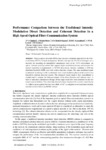Performance Comparison between the Traditional Intensity Modulation Direct Detection and Coherent Detection in a High Speed Optical Fibre Communication System
| dc.contributor.author | Chabata, T V | |
| dc.contributor.author | Boiyo, Kiboi | |
| dc.contributor.author | Kipnoo, Rotich E K | |
| dc.contributor.author | Gamatham, R R G | |
| dc.contributor.author | Leitch, A W R | |
| dc.contributor.author | Gibbon, T B | |
| dc.date.accessioned | 2019-09-11T08:40:00Z | |
| dc.date.available | 2019-09-11T08:40:00Z | |
| dc.date.issued | 2015 | |
| dc.identifier.uri | http://ir.mksu.ac.ke/handle/123456780/4798 | |
| dc.description.abstract | Passive optical networks (PONs) have become a dominant approach for the fibreto–the-home (FTTH) network deployments. Reliable and spectral efficient technologies are a necessity for extending the unamplified transmission reach in the FTTH environment. An optical coherent detection scheme that supports higher modulation formats and increases the receiver sensitivity is implemented. A 10 Gb/s data stream, intensity modulates a 1550 nm distributed feedback (DFB) laser with a direct detection scheme. The same modulated signal is enhanced by mixing it with a continuous wave (local oscillator) placed at the receiver in a homodyne coherent detection scheme. The enhanced mixed signal is then demodulated to evaluate and to compare the link performance of the direct detection and coherent cases. A back to back and a transmission through 30 km single mode fibre were simulated for the two transmission modalities. The coherently detected scheme improved the receiver sensitivity by 12.1 dBm at an acceptable bit error ratio (BER) of 10-9 as compared to the traditional intensity modulation direct detection (IMDD) scheme. | en_US |
| dc.language.iso | en_US | en_US |
| dc.title | Performance Comparison between the Traditional Intensity Modulation Direct Detection and Coherent Detection in a High Speed Optical Fibre Communication System | en_US |
| dc.type | Article | en_US |
Files in this item
This item appears in the following Collection(s)
-
School of Pure and Applied Sciences [259]
Scholarly Articles by Faculty & Students in the School of Pure and Applied Sciences

